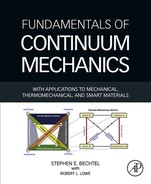Different Notions of Invariance
The subject of invariance requirements is controversial among continuum mechanicists. One group contends that the constitutive equations must be invariant under all possible superposed rigid body motions of the body. That is, if two motions of a body composed of the same material differ by only a superposed rigid body motion, then physically the internal response generated in the two motions must be the same, apart from orientation. This is the invariance requirement employed in this textbook; refer, for instance, to Sections 5.2.1, 5.4.1, and 9.6.4. Hooke, Poisson, and Cauchy are historical figures associated with the development of this requirement.
Another group of continuum mechanicists contends that the constitutive equations must be invariant under an arbitrary motion of the observer. In other words, the body does not move, but instead the coordinate axes can rotate and translate rigidly, and reflect. To this concept is attached the title principle of material frame indifference, principle of material objectivity, or objectivity, and associated with it are the historical figures Zaremba and Jaumann.
The conceptual bases for these two notions of invariance are very different, but in application the difference between them reduces to the following: the tensor Q in this book is proper orthogonal (QQT = QTQ = I and det Q = 1) for invariance under superposed rigid body motions, whereas Q is merely orthogonal (QQT = QTQ = I and det Q = ±1) for use in the principle of material frame indifference. This is because a body cannot turn itself inside out, but a set of coordinate axes can.
Note that a constitutive equation satisfying the principle of material frame indifference is also invariant under superposed rigid body motions: if a statement holds for all orthogonal Q, then it holds for all proper orthogonal Q as well (all proper orthogonal tensors are also orthogonal). The converse is not true: a constitutive equation that is invariant under superposed rigid body motions does not necessarily satisfy the principle of material frame indifference. Therefore, the requirement of material frame indifference is more restrictive than the requirement of invariance under superposed rigid body motions.
